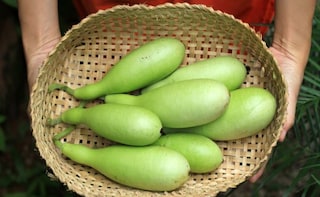“In summer, the standard lunch in our home in Allahabad would be a dry preparation of parval-aloo and the yellow arhar dal. The menu never changed. We had parval every single day! My dad still expects to,” says a friend of mine as we talk about summer vegetables in India and how reviled the gourds— lauki, tori, tinda and yes, parval, tend to be for most of the younger, metropolitan diners. Before the advent of the tasteless cauliflowers, broccoli and fancier veggies, it was the gourds that ruled summer. Parval, pointed gourd as it is sometimes called, has been one of the few indigenous vegetables in India—grown in UP and the eastern part of the Indo-Gangetic-Brahmaputra plains widely. Its vines lie dormant in winter and then come to fruition in the rich clay soil of the Ganga-Jamuni plain as the weather gets warmer.
Then, you have sweets such as petha, the famous Agra tradition where the ash gourd is cooked in sugar syrup, which must have been quite an innovation when it was invented. Both the petha and sweets like lauki ka halwa were delicacies said to have been innovated upon in the Mughal kitchens. But we need to look no further than the sitar to see how India’s syncretic cultural tradition can be represented by the humble kaddu; gourd!
Gourds can of course be used innovatively in modern ways. You can stuff them in ravioli or toss them in olive oil for a light appetiser or salad. But one of the most interesting uses, I find, is in Thai curries. Like Indian food traditions, Thai food has particular combinations of ingredients that go into each dish according to which region in Thailand you are. The complexity may not be immediately perceptible to outsiders. But if you are using pumpkin or ash gourd, use it in a red curry—that calls for a little sweetness. Bottle gourd, on the other hand, can go into a milder yellow curry. Both can be combined with meats—yellow curry with fish or prawn; red with duck.Lauki or bottle gourd is also a favourite with weight-watchers and those in general inclined to healthier eating in summer. It is light—one of the vegetables with the fewest calories, giving you just 14 per 100 gram. Folates in it is also good for the development of the foetus if taken by expectant mothers. Then there are other nutrients like calcium and zinc and also vitamin C, making the bottle gourd a super food full of antioxidants too. What you need to be careful about is bottle gourd poisoning from raw juice. If the bottle gourd is bitter, do not consume it: Some bottle gourds develop naturally occurring cucurbitacins in excess and may accumulate toxic compounds.This is a precaution in fact you need to take against bitter gourd as well, otherwise quite a wonderous vegetable, helping everything from weight loss to diabetes management. The bitter toxic compound is why you scrape the skin off. Salt it a little to remove the bitter and then stir fry, or stuff it with mince or onions and fry (or stir fry). It’s a summer of plenty.
Bottle gourd is a super food full of antioxidants
Then, you have sweets such as petha, the famous Agra tradition where the ash gourd is cooked in sugar syrup, which must have been quite an innovation when it was invented. Both the petha and sweets like lauki ka halwa were delicacies said to have been innovated upon in the Mughal kitchens. But we need to look no further than the sitar to see how India’s syncretic cultural tradition can be represented by the humble kaddu; gourd!
Advertisement
Gourds can of course be used innovatively in modern ways. You can stuff them in ravioli or toss them in olive oil for a light appetiser or salad. But one of the most interesting uses, I find, is in Thai curries. Like Indian food traditions, Thai food has particular combinations of ingredients that go into each dish according to which region in Thailand you are. The complexity may not be immediately perceptible to outsiders. But if you are using pumpkin or ash gourd, use it in a red curry—that calls for a little sweetness. Bottle gourd, on the other hand, can go into a milder yellow curry. Both can be combined with meats—yellow curry with fish or prawn; red with duck.Lauki or bottle gourd is also a favourite with weight-watchers and those in general inclined to healthier eating in summer. It is light—one of the vegetables with the fewest calories, giving you just 14 per 100 gram. Folates in it is also good for the development of the foetus if taken by expectant mothers. Then there are other nutrients like calcium and zinc and also vitamin C, making the bottle gourd a super food full of antioxidants too. What you need to be careful about is bottle gourd poisoning from raw juice. If the bottle gourd is bitter, do not consume it: Some bottle gourds develop naturally occurring cucurbitacins in excess and may accumulate toxic compounds.This is a precaution in fact you need to take against bitter gourd as well, otherwise quite a wonderous vegetable, helping everything from weight loss to diabetes management. The bitter toxic compound is why you scrape the skin off. Salt it a little to remove the bitter and then stir fry, or stuff it with mince or onions and fry (or stir fry). It’s a summer of plenty.
Advertisement
For the latest food news, health tips and recipes, like us on Facebook or follow us on Twitter and YouTube.
Advertisement
